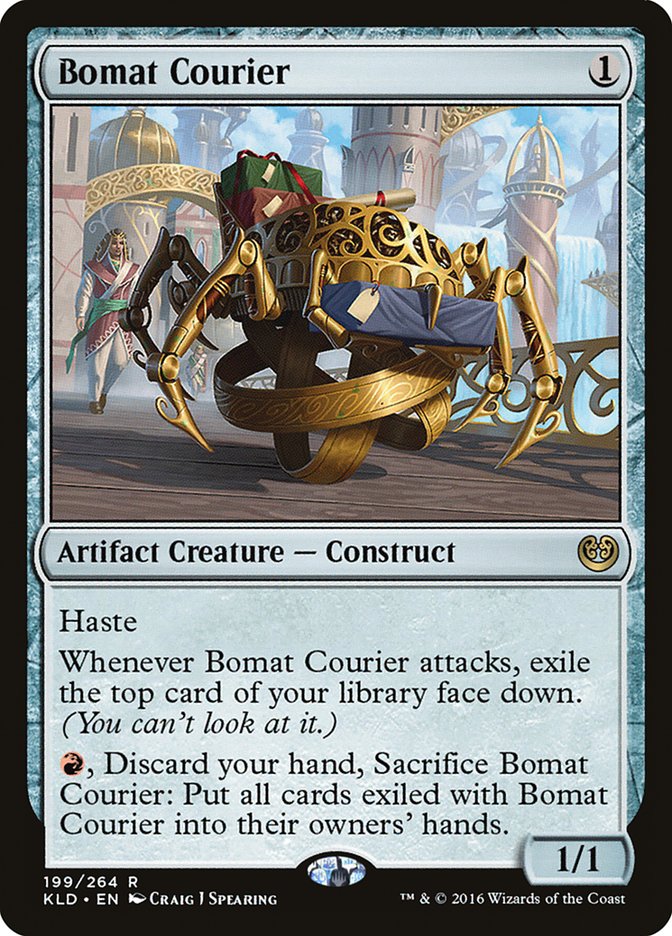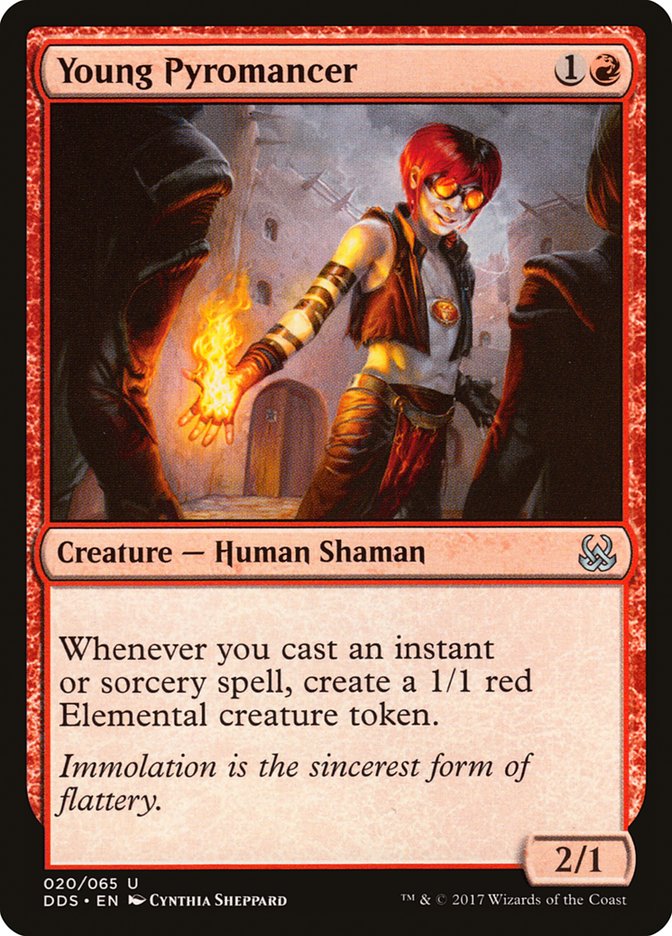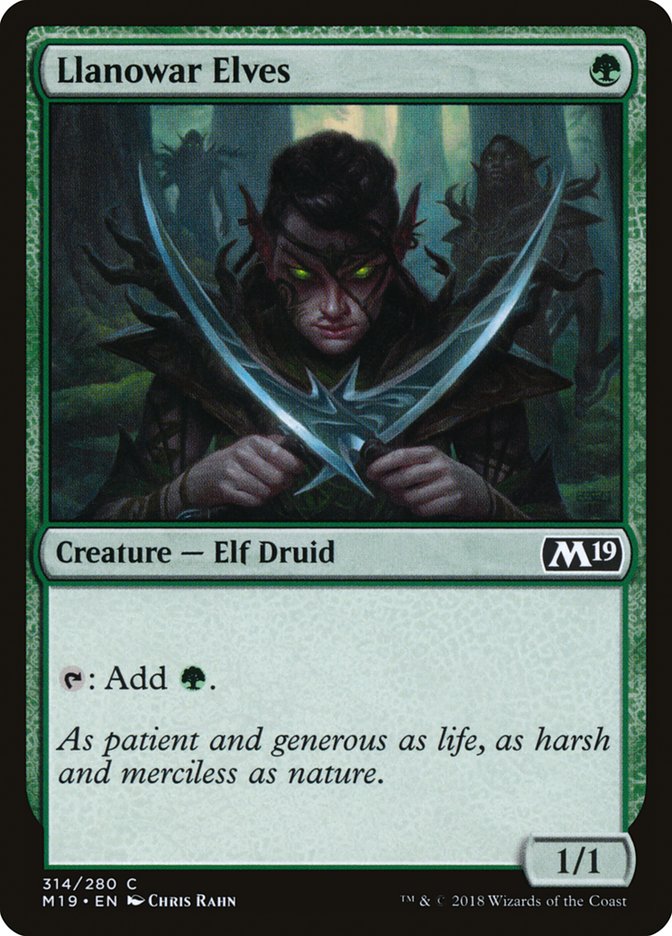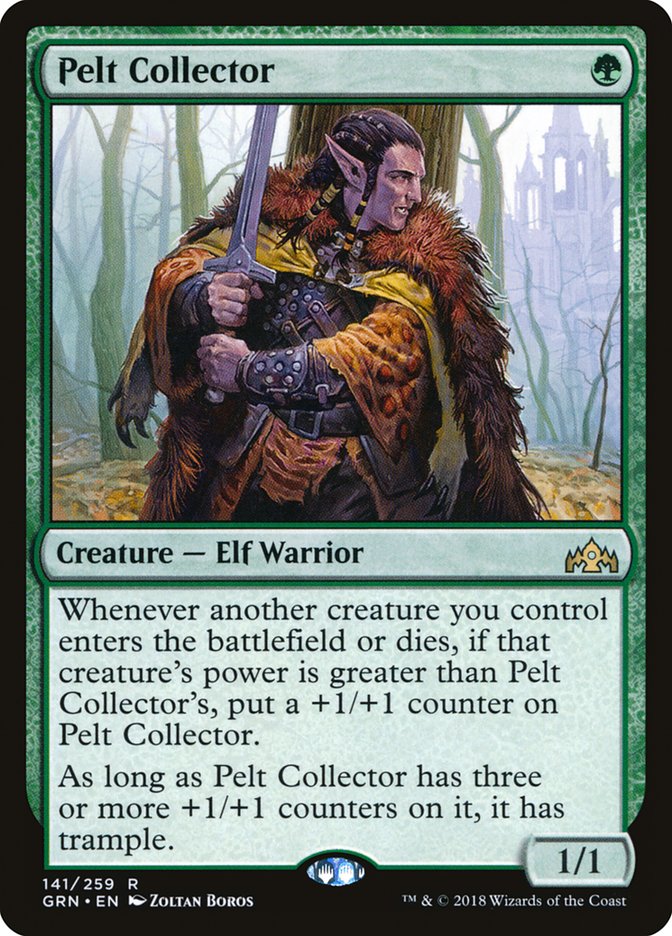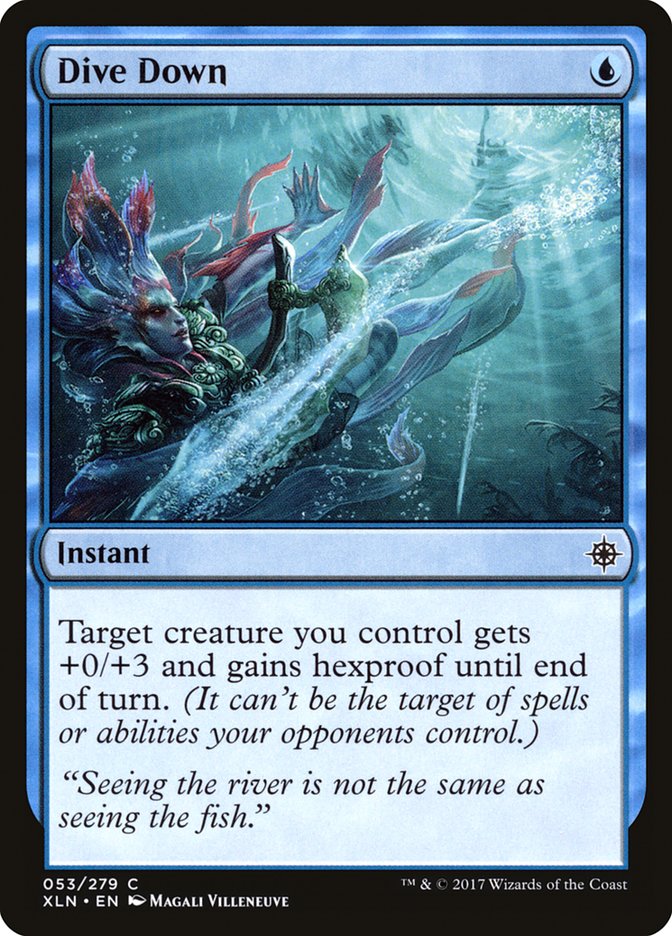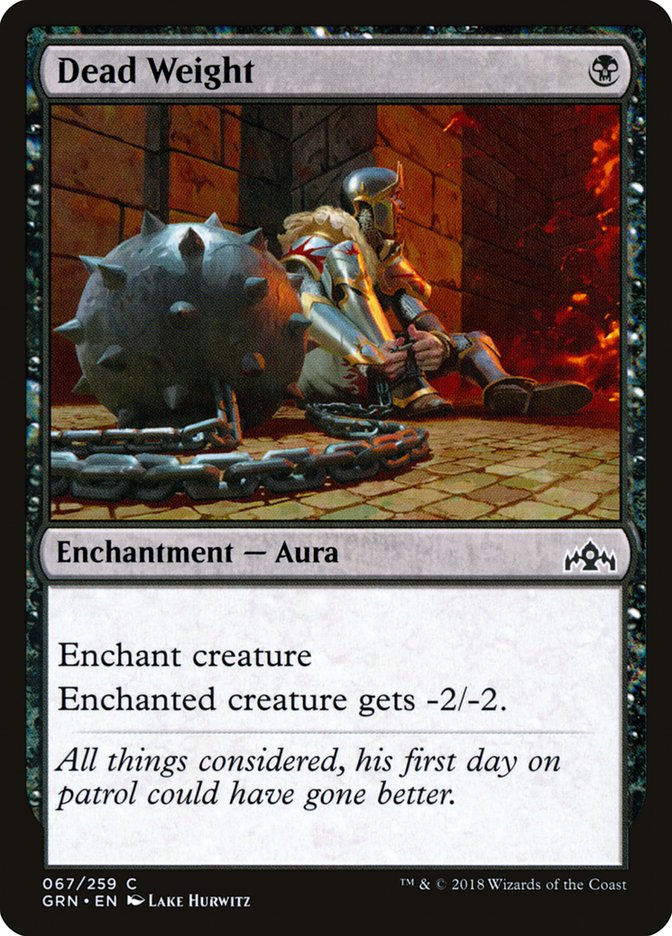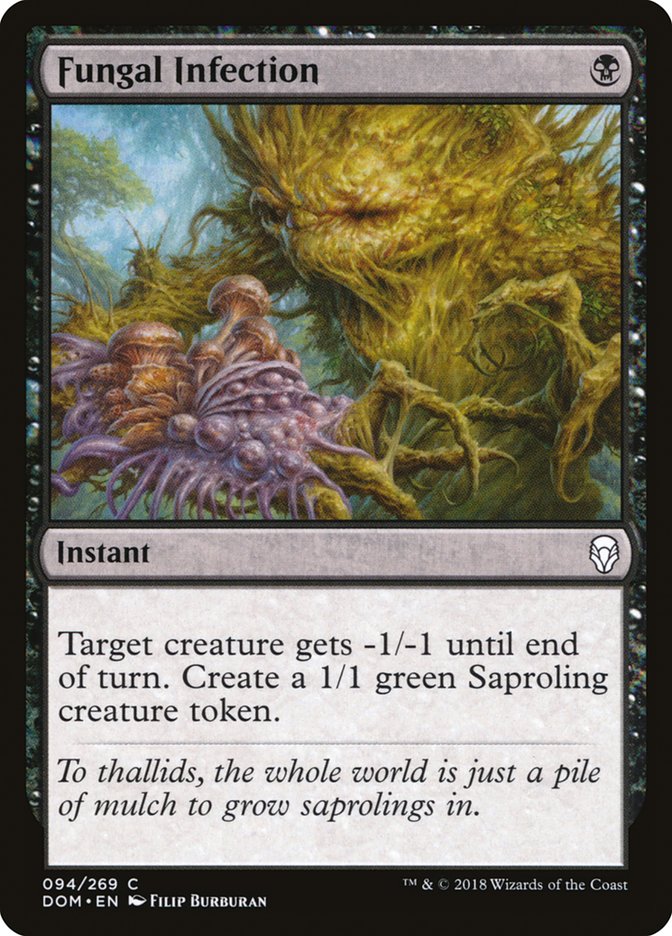Steph Courier. The Mailman. Young Bomie C. Wheel of Fortune + Lava Axe.
The big open secret of Rakdos Aggro’s dominance over the last six months of Dominaria and Core Set 2019 Standard was that Bomat
Courier offered it the most indispensable of effects: the must-answer
one-drop.
Sure, Goblin Chainwhirler kept cards like Llanowar Elves down, and made
life difficult for those of us who enjoyed Glint-Sleeve Siphoner or
Champion of Wits, but Bomat Courier is what allowed those
aggressively-slanted midrange decks to beat up on control and pin the
metagame in place. In concert with backup one-drop Soul-Scar Mage, Bomat
Courier gave free wins to red aggro decks by offering a few points of
chip-shot damage and a fresh set of cards in the middle turns. All this for
the low investment of a mana up front and one to sacrifice made Bomat
Courier the best Raging Goblin a player could ask for. Without it, Rakdos
Aggro would have been a middling second-stringer compared to The Scarab God
and Teferi-based midrange and control decks.
While Goblin Chainwhirler, Chandra, Torch of Defiance, Rekindling Phoenix,
and Hazoret the Fervent played more visible roles in dunking on opponents,
it was Bomat Courier who brought the proverbial ball up the court and
forced those same opponents into awkward defensive positions. The starts
where Rakdos Aggro didn’t present this turn-one ticking time bomb were so
much less stressful for an opponent than the ones with the little
Construct, and it seems like folks haven’t yet internalized that lesson for
Guilds of Ravnica Standard.
It’s time to respect our one-drops.
Long ago, when I first started devouring Magic strategy content, I remember
reading in a Mike Flores preview article for the card Spell Snare (ironic,
considering we’re right back on Ravnica where we started) that “Tournament
Magic is a game increasingly defined by two-drops.” For many, many years,
this axiom has held true. Look at some of the most iconic cards in Modern
and Legacy!
These five are frequently cited as the powerful cycle of color-defining
two-drops, cards that change the tenor of the game when they hit play.
Undoubtedly, these are incredible cards, cards that defined formats, cards
that changed the way we look at deckbuilding. However, of late they are
cards that don’t do the whole job themselves. A lone Dark Confidant on turn
two is often too slow for Modern. A Tarmogoyf just gets hit with a Fatal
Push and the opponent keeps going. What happened?
Personally, I blame Fatal Push. The best removal spell printed in years
turned Tarmogoyf into a liability, allowed black decks to have a higher
density of flexible removal to answer Young Pyromancer and Dark Confidant,
and put all two-drops on watch. In Standard, similarly, it placed a gentle
pressure on decks to play threats that either traded on mana parity
(one-drops), had an immediate effect on the battlefield regardless of
removal (Chainwhirler), or just avoided the issue completely (The Scarab
God, Glorybringer, Hazoret, Teferi).
But the issue that Fatal Push brought into stark contrast has been
developing for at least a decade. We’ve known about the power of playing
multiple spells in the same turn cycle (typically some combination of,
answer, threat, or protective trick) for some time now. It’s time to make
this as clear as possible.
We are in a new era. Tournament Magic, increasingly, is a game defined by
powerful one-drops. It started with cards like Noble Hierarch and
Deathrite Shaman, mana accelerants that didn’t go dead in the mid- and
late-game. In Modern, we see Humans players being advised to mulligan any
hand without Aether Vial, Champion of the Parish, or Noble Hierarch. My
longtime flame, Grixis Death’s Shadow, works because nearly every card in
the deck costs one mana. Tarmogoyf may be a 4/5 for two, but Gurmag Angler
is a 5/5 for one, and Death’s Shadow is upwards of a 10/10 for one. Sure,
these aren’t deployed on the first turn, but the idea is that they slip
into the curve so well on a double-spell or even triple-spell turn in the
midgame. Constructed Magic has long been about those key double-spell turns
between turns two and five, and one-casting-cost cards are the best
possible way to get those massive swings. Starting the game on turn two is
not good enough in Modern, and though it’s often passable in Standard,
there’s a huge advantage to be gained from playing a fistful of the
cheapest cards around. It’s time for a new paradigm, and we need to build
our decks to account for this.
I see so many new Guilds of Ravnica Standard decks with a scant
four one-casting-cost spells. Maybe it’s four Thoughtbound Phantasm in your
Turbo Surveil deck, or just four Llanowar Elves in your Golgari Midrange
deck. I even see Grixis Control decks with no one-casting-cost removal at
all! This is shoddy deckbuilding, and it will soon be wrung out of the
format. Greedy, optimistic deckbuilders love to pack their lists full of
powerful heavy hitters, but the key to success is giving yourself the
opportunity to press down on the accelerator on turn one or stop your
opponent from doing the same. The best of these cards gives a player the
opportunity to have a double-spell turn in the midgame, to parry a threat
and deploy or protect one of their own.
At a very simple level, part of the reason I wrote at length about
Mono-Green Aggro
last week
was to get a list out there for the most basic, straightforward deck that
incorporated eight one-drops. Llanowar Elves has been a staple of
tournament Magic for many years, and Pelt Collector is one of those rare
one-drops that remains potent well into the middle turns, even as a late
topdeck. A Grixis Control or Dimir Control list with no way to answer these
creatures for mana parity is going to be unapologetically weeded out of the
format.
It’s with this mindset that I approach basically every decklist I see for
the new Standard format, as it’s a helpful (though not perfect, of course)
heuristic for judging if a deck designer is too optimistic about being able
to beat fast starts from the opponent.
Let’s take a key example, from two skilled players who have offered
suggestions for the potent and exciting Turbo Surveil deck.
Creatures (21)
- 2 Exclusion Mage
- 4 Nightveil Sprite
- 4 Doom Whisperer
- 4 Thoughtbound Phantasm
- 3 Lazav, the Multifarious
- 4 Dimir Spybug
Lands (22)
Spells (17)
Sideboard

Creatures (16)
Lands (25)
Spells (19)
- 4 Vraska's Contempt
- 1 Search for Azcanta
- 1 Arguel's Blood Fast
- 4 Thought Erasure
- 4 Sinister Sabotage
- 2 Notion Rain
- 3 Discovery
Sideboard

-
Todd’s list has four Thoughtbound Phantasm, three Dead Weight, and
two Spell Pierce. Bravo, Todd! -
Owen’s list has four Thoughtbound Phantasm and a bunch of extra
three-drops. Boo, Owen!
Let’s talk a little about why we should cheer Todd’s example, and what
changes I’d suggest.
Todd’s deck can catch up from being on the draw. If Owen’s opponent leads
with Llanowar Elves, his Turbo Surveil list is just going to fall apart to
an onslaught of aggressive green monsters. He can’t catch up. Todd can
parry with Dead Weight or play a Phantasm with intent to follow up with an
Exclusion Mage to bring back some tempo.
Todd’s list can double-spell to make an opponent weep. Protecting a Dimir
Spybug with Spell Pierce while simultaneously deploying a Lazav, the
Multifarious is an easy way to slam dunk a win. This is even more glaringly
apparent in a deck with Notion Rain to keep the gas flowing.
Now, Todd’s list isn’t perfect by any means. I’m a big fan of Dive Down
over Spell Pierce for several reasons, and I’ll be starting my Dimir
Surveil lists with two or three of the blue Blossoming Defense for sure.
The difference when it comes to protecting a massive Doom Whisperer is
stark, especially considering that by the time Doom Whisperer comes down
the opponent will typically have more than enough mana to pay for Spell
Pierce. Countering a Vraska’s Contempt or Assassin’s Trophy on a big Doom
Whisperer is often enough to just take the game then and there. Not to
mention that several decks in Guilds of Ravnica Standard will have
somewhere between three and ten noncreature spells, which makes Spell
Pierce look more like Smell Pierce.
If Azorius Control (or even Bant Nexus!) comes back into vogue in a big
way, it will be time to re-evaluate our one-mana trick of choice, but
unless Jim Davis’ prediction of a Teferi revival comes true, I’ll be
sticking with the trick that stops spot removal dead in its tracks no
matter what.
Dead Weight, too, is a fine card, but not necessarily better than one we’ve
had at our disposal for a few months now. Fungal Infection parries Llanowar
Elves and Pelt Collector but offers the potential of a clean two-for-one in
rare circumstances. Against Ghitu Lavarunner, for example, a turn-two
Fungal Infection on the attack can gobble up the 1/2 and leave behind a
valuable blocker for future Goblin Bannerets or Lightning Mares. Being an
instant, of course, is icing on the cake, as is generating a chump blocker
for those frequent racing situations the surveil deck will often create.
I’ve already seen firsthand the power of a single chumping Saproling
against an angry Vine Mare or Nullhide Ferox.
The only scary card that Dead Weight answers that Fungal Infection does not
is Legion Warboss. A Goblin Rabblemaster-style effect is worrisome, to be
sure. If the Warboss ends up being a large player in the Standard metagame,
I will step back on Fungal Infection and permit Dead Weight to take the
slot in my Dimir decks, but until then I’ll try to use the unexpected
instant-speed effect when possible.
The best decks at the start of this Standard format are overwhelmingly
likely to be the ones that make best use of the best one-casting-cost
spells:
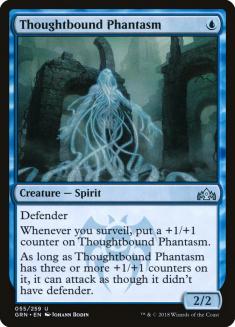
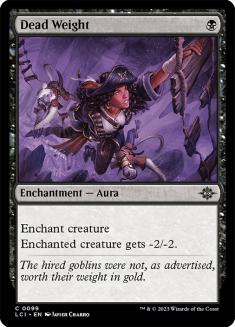
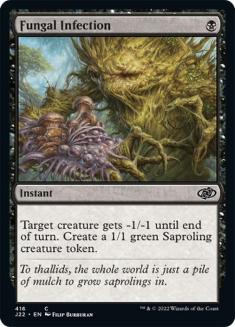
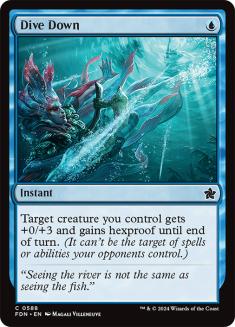
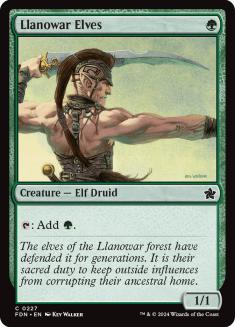
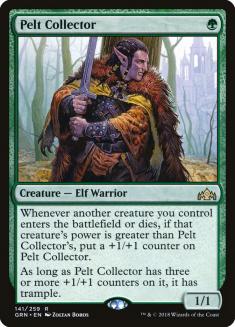
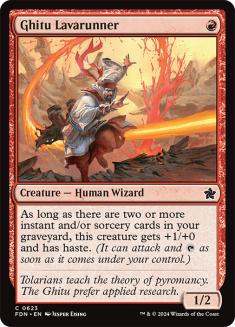
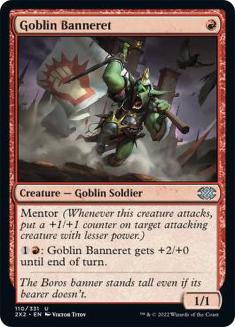

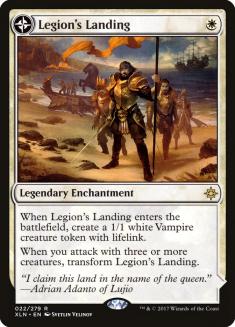
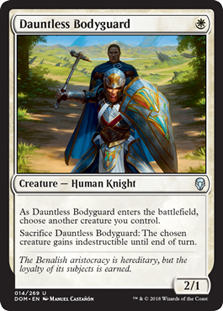

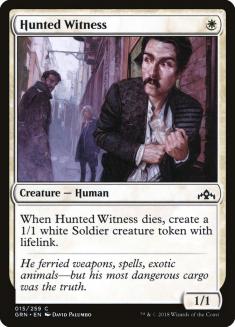
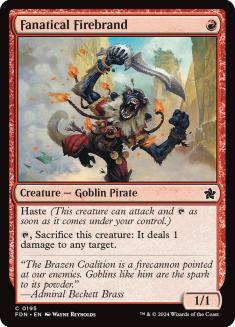
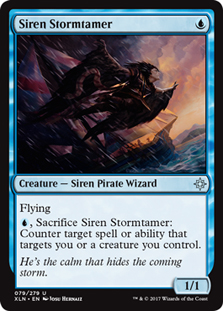

Try to find ways to use these cards before building midrange three-color
piles that can’t quite keep up. I’m looking at you,
Sultai/Abzan/Jeskai/Grixis/Naya players! Try beating Mono-Red Aggro,
Mono-Blue Aggro, or Mono-Green Aggro first, then come back when you find a
way to beat the decks with the one-drops.
My recommendation? Play a few of your own. There’s no shame in a Grixis
Control deck with six one-mana removal spells in the 75. Dead Weight and
Golgari Findbroker go together like peas and carrots. Legion’s Landing is
one of the best enablers for Selesnya decks I’ve seen. The cards are there,
and it’s not like they’re new or unknown.
Of course, there’s still the omnipresent threat of Teferi, whether with
Cleansing Nova or Nexus of Fate. Sweepers and Fog effects have their own
set of weird rules for building with or building against. Tempo is less
important when you can catch up in one fell swoop with a solid sweeper. In
the right metagame, these Teferi decks could become real predators. But
that’s why we have Duress and Disdainful Stroke, right?
It’s going to be an exciting opening weekend for Standard at SCG Columbus.
Just make sure you aren’t starting off behind the competition with a deck
full of clunkers.


